We may not have the course you’re looking for. If you enquire or give us a call on 01344203999 and speak to our training experts, we may still be able to help with your training requirements.
Training Outcomes Within Your Budget!
We ensure quality, budget-alignment, and timely delivery by our expert instructors.
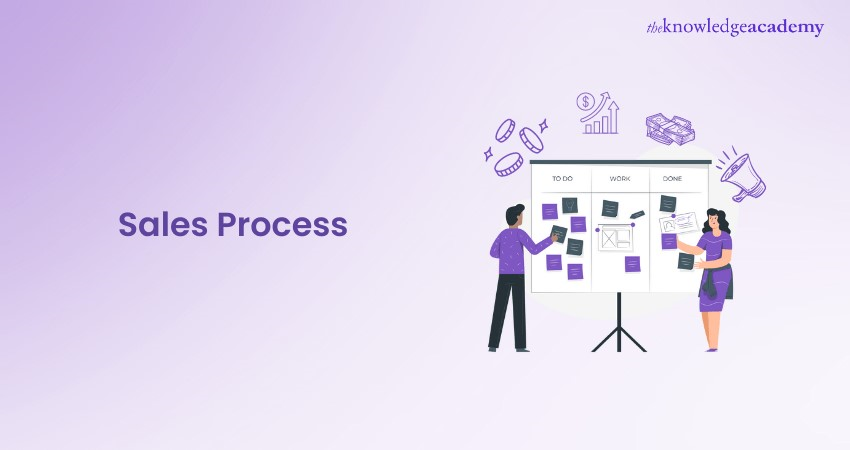
The Sales Process stands as a guiding compass for the commerce roadmap, leading businesses towards their ultimate goal: Successful transactions and lasting customer relationships. At its core, the Sales Process is a strategic sequence of steps meticulously designed to guide potential customers from initial engagement to the point of commitment. In this blog, we will expand on the intricacies of the Sales Process, exploring each step with ample precision and insight.
Table of Contents
1) What is the Sales Process?
2) Steps of the Sales Process
a) Pre-Sales preparation
b) Prospecting
c) Initial contact
d) Needs assessment
e) Presentation and demonstration
f) Proposal and negotiation
g) Closing the deal
h) Follow-up and relationship-building
i) Metrics and analysis
j) Continuous improvement
3) Benefits of the Sales Process
4) How to improve your Sales Process?
5) Conclusion
What is the Sales Process?
At the heart of successful business transactions lies the concept of a Sales Process, a meticulously structured sequence of steps that guides organisations in turning prospects into loyal customers. It serves as a strategic roadmap, outlining the journey from initial contact to final conversion. Like a choreographed dance, the Sales Process orchestrates every interaction, communication, and negotiation to optimise engagement, maximise conversions, and foster enduring relationships.
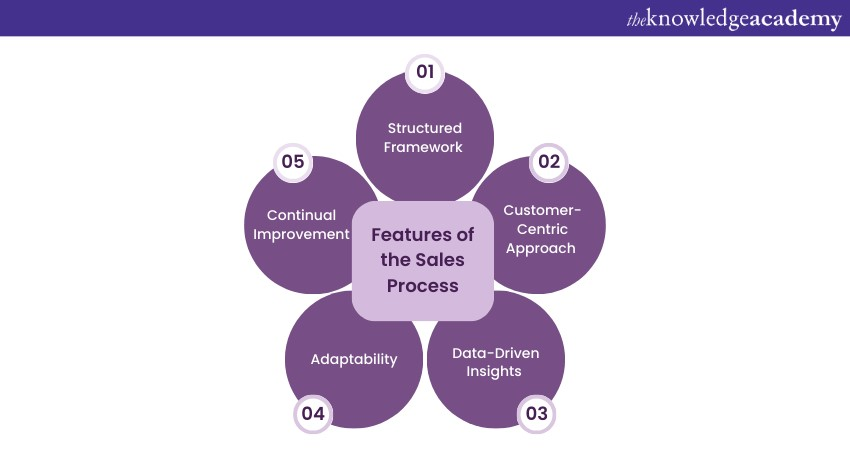
A Sales Process is not a one-size-fits-all formula; rather, it's a customisable framework that adapts to different industries, products, and customer behaviours. It encompasses various stages, each designed to align with the customer's decision-making journey. This journey typically starts with prospecting – identifying potential leads – followed by needs assessment, presentation, negotiation, and ultimately, closing the deal.
Throughout this process, the customer is the focal point. Effective Sales Processes involve Active Listening, empathy, and a tailored approach to fulfil their specific needs and pain points. Additionally, a well-structured Sales Process often extends beyond the initial transaction, nurturing post-sale relationships through follow-ups and ongoing support.
In essence, a Sales Process encapsulates the art and science of successful selling. It empowers businesses to navigate the complex landscape of customer interactions with purpose and precision. By embracing this structured approach, organisations can enhance customer satisfaction, maximise revenue potential, and create a sustainable foundation for business growth.
Elevate your Sales expertise with our Sales Management Training – empower your team and transform your results!
Steps of the Sales Process
This section of the blog will expand on the different steps of the Sales Process:
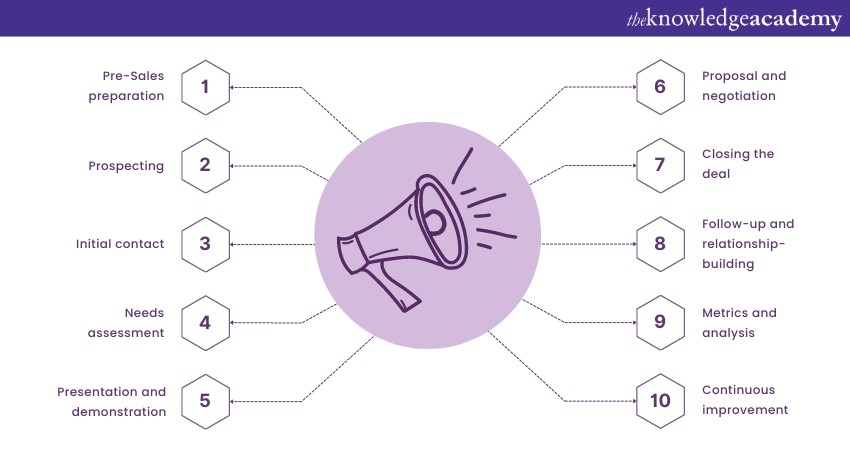
Pre-Sales preparation
Embarking on the journey of Sales demands meticulous pre-Sales preparation. This foundational step equips you with the tools and knowledge required to navigate the intricate world of Sales successfully:
1) Understanding your product/service: Cultivate a profound understanding of the intricacies of your product or service. Delve into its features, benefits, and unique selling points. This comprehensive grasp empowers you to articulate its virtues and benefits persuasively to potential customers.
2) Identifying target audience: Through rigorous research, identify the demographic and psychographic segments that align seamlessly with your offerings. This knowledge guides your approach, ensuring that your messaging and strategies are tailored to resonate with the needs of your target audience.
3) Creating ideal customer profiles: Craft intricate profiles that serve as archetypes of your ideal customers. These profiles encompass details like age, gender, profession, pain points, aspirations, and buying behaviours. They serve as a roadmap for tailoring your messaging, solutions, and strategies to cater to the unique requirements of each customer persona.
4) Setting clear Sales goals: Define your Sales objectives with clarity and precision. These well-defined goals provide a roadmap, directing your efforts toward tangible outcomes that align with your overarching business strategy. Whether your aim is to achieve a certain revenue target, expand market share, or increase customer retention, having clear goals guides your actions.
Prospecting
The realm of prospecting serves as the gateway to potential clients. By strategically identifying and prioritising leads, you optimise your efforts and enhance the likelihood of successful conversions:
1) Lead generation strategies: Employ a diverse range of lead generation strategies, encompassing both inbound and outbound methods. From thoughtfully curated content and engaging social media campaigns to proactive outreach through cold calls and networking events, these strategies broaden your pool of prospects and create multiple touchpoints for engagement.
2) Qualifying leads: Undertake a discerning assessment of leads to ascertain their alignment with your ideal customer profiles. Not all leads are created equal; some might be more likely to convert than others. By evaluating factors like their level of interest, budget, authority to make decisions, and timeline, you can determine which leads are worth investing your time and resources into.
3) Prioritising leads for outreach: Employ a tiered approach to prioritise leads based on their level of interest and potential value. This systematic hierarchy ensures that your outreach efforts are targeted and effective. By focusing on leads that exhibit a higher level of engagement and readiness to move forward, you optimise your chances of securing conversions.
Initial contact
The initial point of contact serves as the stepping stone for the ensuing relationship. Nurturing a positive and meaningful introduction lays the foundation for productive interactions:
1) Crafting a compelling elevator pitch: Construct a succinct yet impactful elevator pitch that encapsulates the essence of your offering. This concise introduction should communicate the core value your product or service brings to the table. By condensing your message into a compelling pitch, you capture attention and spark curiosity, laying the groundwork for deeper engagement.
2) Different modes of communication: Tailor your communication approach to suit the preferences of your prospects. Whether it's the warmth of a personal call, the professionalism of a well-crafted email, or the accessibility of a direct message on social media, adapting to their preferred mode of communication enhances the likelihood of making a connection.
3) Building rapport and trust: Forge a genuine connection through active listening and empathetic communication. The initial contact is an opportunity to establish rapport and trust. By showing a sincere interest in understanding the prospect's challenges, needs, and aspirations, you create an environment conducive to open dialogue and future collaboration.
Needs assessment
This pivotal phase involves delving deep into the prospect's needs and challenges, laying the foundation for crafting bespoke solutions that resonate profoundly:
1) Asking the right questions: Artfully formulate open-ended questions that invite prospects to share their pain points, desires, and aspirations. Through this interactive dialogue, you gain insights into their unique circumstances, providing valuable information for tailoring your approach.
2) Actively listening to customer pain points: Demonstrate active listening skills, attentively absorbing the prospect's challenges and concerns. This not only informs your approach but also establishes a sense of empathy, showing that you genuinely care about addressing their specific needs.
3) Tailoring solutions to customer needs: Armed with a comprehensive understanding of the prospect's pain points, present your product or service as the perfect antidote. By aligning the features and benefits of your offering with their specific challenges, you elevate its value proposition and relevance.
Presentation and demonstration
This phase serves as the platform for showcasing your product or service, spotlighting its features, benefits, and overall value proposition:
1) Structuring an engaging presentation: Organise your presentation coherently, leading the prospect through a logical sequence that highlights how your offering directly addresses their pain points. A well-structured presentation maintains engagement and guides the prospect through the key points.
2) Highlighting key benefits and features: Emphasise the unique features and benefits that resonate most with the prospect's needs. Tailoring your presentation to their specific pain points and aspirations increases the likelihood of capturing their interest and generating enthusiasm.
3) Addressing customer concerns and objections: Be prepared to address any concerns the prospect may express. Anticipate potential hesitations and provide well-considered responses that dispel doubts. This demonstrates your expertise and reinforces your commitment to their satisfaction.
Elevate your Sales prowess with our comprehensive Online Sales Training - unlock your potential today!
Proposal and negotiation
This phase involves presenting a compelling proposal and engaging in negotiations to arrive at a mutually agreeable arrangement:
1) Creating persuasive proposals: Develop a comprehensive proposal that eloquently outlines the value proposition of your offering. Clearly delineate the features, benefits, pricing, and terms, conveying a compelling case for your product or service.
2) Pricing strategies and discounting: Deploy pricing strategies that mirror the value your solution offers. Use discounts judiciously, ensuring they enhance the attractiveness of your offer without undermining its perceived quality.
3) Negotiation techniques for win-win deals: Approach negotiations with a collaborative spirit, aiming for an outcome that benefits both parties. Employ active listening, adaptability, and innovative problem-solving to navigate negotiations with finesse.
Closing the deal
This phase involves presenting a compelling proposal and engaging in negotiations to arrive at a mutually agreeable arrangement:
1) Creating persuasive proposals: Develop a comprehensive proposal that eloquently outlines the value proposition of your offering. Clearly delineate the features, benefits, pricing, and terms, conveying a compelling case for your product or service.
2) Pricing strategies and discounting: Deploy pricing strategies that mirror the value your solution offers. Use discounts judiciously, ensuring they enhance the attractiveness of your offer without undermining its perceived quality.
3) Negotiation techniques for win-win deals: Approach negotiations with a collaborative spirit, aiming for an outcome that benefits both parties. Employ active listening, adaptability, and innovative problem-solving to navigate negotiations with finesse.
Follow-up and relationship-building
After sealing the deal, the process of nurturing relationships and maintaining customer satisfaction begins. This phase is instrumental in fostering long-term partnerships and generating potential referrals:
1) Expressing gratitude and professionalism: Extend a sincere thank-you message to the new customer. This gesture demonstrates appreciation for their trust and sets a professional tone for the relationship.
2) Ensuring customer satisfaction: Regularly check in with the customer to measure their satisfaction with the product. Address any post-purchase concerns promptly, showing your dedication to their success.
3) Nurturing long-term relationships: Provide value beyond the initial sale by sharing relevant content, updates, and insights. By nurturing the relationship, you position yourself as a trusted advisor, encouraging repeat business and referrals.
Metrics and analysis
The measurement and analysis of Sales performance provide insights into the efficiency of your Sales strategies, enabling continuous refinement:
1) Tracking key Sales metrics: Monitor critical metrics such as Sales cycle length, conversion rates, and average deal size. These metrics offer a quantitative overview of your team's performance and help identify areas for improvement.
2) Evaluating Sales performance: Compare your actual results with the set Sales goals. By analysing the gaps between target and actual performance, you can make informed decisions and adjust strategies accordingly.
3) Identifying areas for improvement: Leverage the data-driven insights gained from analysis to pinpoint areas that require enhancement. Whether it's refining your lead generation methods or fine-tuning objection-handling techniques, data guides informed improvements.
Continuous improvement
An ever-evolving Sales Process ensures your strategies remain effective amidst changing market dynamics and customer preferences:
1) Learning from successes and failures: Reflect on both successful deals and missed opportunities. Analyse what worked well and where improvements could be made, translating lessons into refined strategies.
2) Training and upskilling Sales team: Invest in continuous training to keep your Sales team updated with industry trends, product knowledge, and cutting-edge selling techniques. A well-informed team yields more confident and effective interactions.
3) Adapting to market changes: The market landscape is dynamic, marked by shifts in customer preferences and industry trends. Be adaptable and ready to pivot your strategies to align with changing market demands.
Elevate your Sales prowess with our Remote Selling Training - Master the art of selling from a distance and excel in the modern business landscape!
Benefits of the Sales Process
In the dynamic theatre of business, where success is a blend of strategy, engagement, and persistence, the Sales Process emerges as a guiding star, illuminating the path to achievement. This methodical sequence of steps serves as a blueprint, enabling businesses to traverse the complex terrain of customer interaction, persuasion, and conversion. The benefits it brings are not mere surface-level advantages but rather transformative outcomes that ripple through every facet of a business's operations:
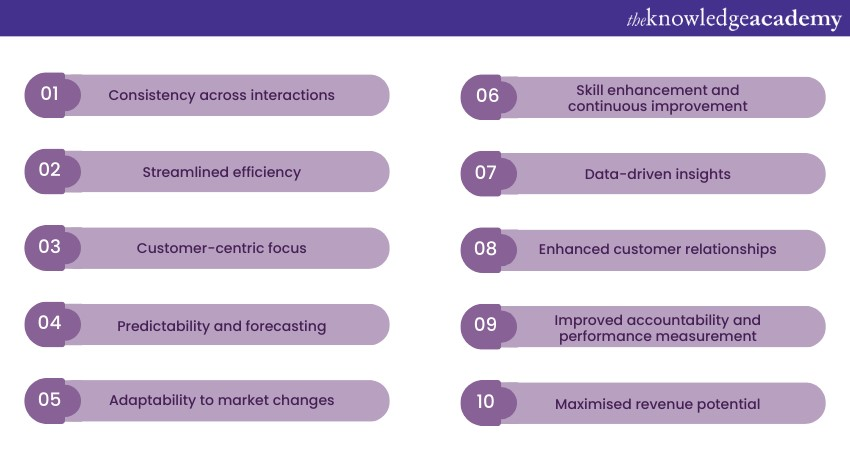
1) Consistency across interactions
Picture a symphony where each instrument plays a different tune. Chaos would reign. Similarly, a Sales Process introduces consistency into interactions with potential customers. Every member of the Sales team adheres to a uniform and structured approach, ensuring that every prospect is treated with professionalism and coherence. This consistency creates a lasting impression of reliability, fostering trust and enhancing the brand's image.
2) Streamlined efficiency
In the hustle and bustle of business, efficiency is a prized asset. A well-defined Sales Process acts as a compass, guiding the Sales team towards optimised resource allocation. By directing efforts towards promising leads, eliminating redundant activities, and minimising time wastage, the process enhances the team's overall productivity.
3) Customer-centric focus
At the core of every successful sale lies an intimate understanding of customer needs. The Sales Process places the customer on a pedestal, encouraging Sales professionals to actively listen, empathise, and tailor solutions that align seamlessly with the prospect's challenges and aspirations. This customer-centric approach not only increases conversion rates but also cultivates trust, loyalty, and lasting relationships.
4) Predictability and forecasting
In the volatile realm of business, predictability is akin to a valuable compass. A well-structured Sales Process offers this compass, providing the data needed for accurate forecasting. By meticulously tracking key performance metrics at each stage, businesses can make informed predictions about revenue generation. This empowers strategic decision-making, enabling better resource allocation and growth planning.
5) Adaptability to market changes
The business landscape is a turbulent sea, influenced by technological advancements, economic shifts, and evolving consumer preferences. A robust Sales Process serves as a ship equipped to weather storms, capable of integrating new strategies and tactics as market conditions evolve. This adaptability ensures that your Sales approach remains effective, even in the face of uncertainty.
Unlock the art of closing deals with our cutting-edge Closing Sales Training – elevate your Sales game today!
6) Skill enhancement and continuous improvement
The Sales Process is a journey of growth, not a static map. By analysing successes and learning from failures at each step, Sales teams can refine their techniques, polish their communication skills, and stay attuned to industry trends. This commitment to ongoing improvement nurtures a culture of excellence and fuels the team's collective success.
7) Data-driven insights
In the era of data, insights are precious gems. A structured Sales Process mines this treasure trove of data, yielding insights into customer behaviour, preferences, objections, and conversion rates. By delving into these insights, businesses can uncover patterns, make informed decisions, and fine-tune strategies for optimal outcomes.
8) Enhanced customer relationships
The Sales Process extends beyond the sale itself, venturing into the realm of post-sale interactions. By nurturing these relationships, staying in regular contact, addressing concerns promptly, and consistently delivering value, businesses can transform customers into fervent advocates who champion their products and services.
9) Improved accountability and performance measurement
Clearly defined stages and metrics within the Sales Process lay the foundation for accountability. Teams can track progress at every juncture, fostering effective performance measurement. This transparency cultivates healthy competition, nurtures a culture of achievement, and aligns individual efforts with overarching goals.
10) Maximised revenue potential
Ultimately, the Sales Process is a bridge to revenue. By strategically guiding prospects from initial engagement to final commitment, the process optimises the likelihood of closing deals. Its systematic approach ensures that no potential revenue slips through the cracks due to inefficiencies or misaligned strategies.
Elevate your Sales game with our Sales Analytics Training – unleash data-driven strategies for unparalleled success!
How to improve your Sales Process?
The following are some tips you must follow to help improve your Sales Process:
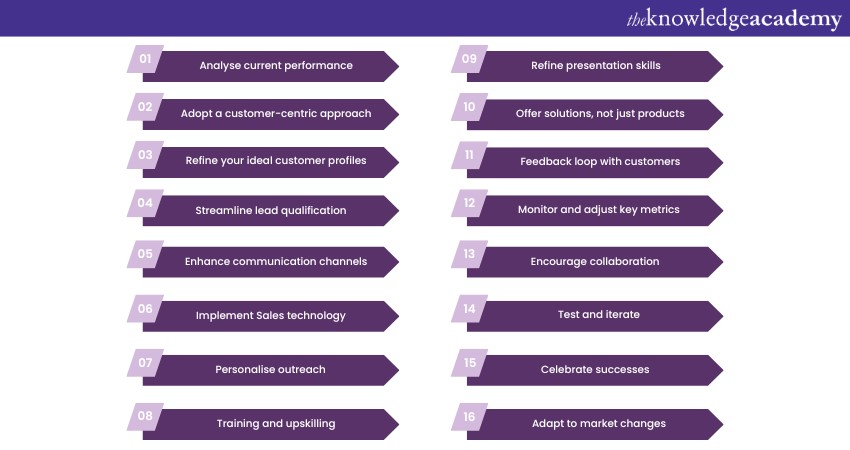
1) Analyse current performance
Begin by scrutinising your existing Sales Process to unearth strengths and weaknesses. Delve into key performance metrics, conversion rates, and feedback from both successful and lost deals. This analysis lays the foundation for informed improvements by identifying bottlenecks and areas of potential growth.
2) Adopt a customer-centric approach
Elevate your approach by putting your customers at the heart of your process. Invest time in understanding their pain points, preferences, and buying behaviours. Craft your interactions and solutions to cater precisely to their needs, cultivating trust and increasing the likelihood of conversions.
3) Refine your ideal customer profiles
Constantly refine and update your ideal customer profiles. This ensures your targeting remains laser-focused, aligning your efforts with the most promising prospects. Tailoring your approach to resonate with these profiles enhances engagement and rapport-building.
4) Streamline lead qualification
Refine your lead qualification process to sift through leads effectively. Develop clear criteria that enable your team to identify and prioritise leads with the highest potential for conversion. This focused approach optimises resource allocation and minimises wasted effort.
5) Enhance communication channels
Extend your reach by exploring new communication channels that resonate with your target audience. Utilise personalised email campaigns, leverage the power of social media engagement, or experiment with dynamic video messages for a multi-faceted approach that captures attention.
6) Implement Sales technology
Embrace cutting-edge Sales technology tools to streamline your process. Equip your team with a robust CRM system, data-driven Sales analytics platforms, and automation tools. These resources enhance efficiency, offer insights, and empower your team to excel.
7) Personalise outreach
Elevate your outreach by crafting bespoke messages for each prospect. Leverage the data you've gathered to create personalised emails, engaging calls, and customised presentations that speak directly to their specific challenges and aspirations.
8) Training and upskilling
Invest in ongoing training to upskill your Sales team. Provide them with advanced selling techniques, negotiation prowess, and in-depth product knowledge. Regular upskilling ensures your team is well-equipped to tackle dynamic challenges.
Master the art of Sales negotiation for lasting business success with our Sales Negotiation Training.
9) Refine presentation skills
Empower your team with refined presentation skills. Train them to deliver compelling narratives, focus on benefits over features, and equip them with strategies to navigate objections skilfully. Engaging presentations leave a lasting impact on prospects.
10) Offer solutions, not just products
Shift the narrative by positioning your offerings as problem-solving solutions. Showcase the transformative impact your product or service brings to the prospect's operations or lives, underscoring its value proposition.
11) Feedback loop with customers
Establish a two-way feedback loop with existing customers. Gather insights into their experiences and suggestions for improvement. Implementing their feedback demonstrates responsiveness and helps fine-tune your process.
12) Monitor and adjust key metrics
Keep a vigilant eye on key Sales metrics like Sales cycle length, conversion rates, and average deal size. Regularly analysing this data unveils patterns and trends, guiding informed adjustments for optimum results.
13) Encourage collaboration
Promote synergy between Sales and marketing teams. Align their strategies to ensure a seamless transition from lead generation to conversion. This collaborative approach nurtures a cohesive and impactful customer journey.
14) Test and iterate
Harness the power of A/B testing to experiment with different aspects of your Sales Process. Evaluate variables like email subject lines, call scripts, or presentation structures. Iterate based on results to refine your approach systematically.
15) Celebrate successes
Acknowledging and celebrating your team's successes is paramount. Positive reinforcement bolsters morale and motivation, inspiring continuous excellence and dedication to enhancing the Sales Process.
16) Adapt to market changes
Stay agile in the face of evolving market dynamics. Regularly assess your Sales Process to ensure its relevance in the current landscape. Adaptability ensures your approach remains a potent force in a dynamic business environment.
Conclusion
The Sales Process is a dynamic and continuous journey that involves a series of well-defined steps. Each phase, from pre-Sales preparation to continuous improvement, contributes to building relationships, driving revenue, and sustaining business growth. By understanding and mastering each step, you can enhance your ability to effectively connect with prospects, address their needs, and establish enduring partnerships. Remember, the key lies in meticulous planning, strategic execution, and a commitment to constant enhancement.
Elevate your Sales prowess today with our comprehensive Sales Training!
Frequently Asked Questions
Upcoming Business Skills Resources Batches & Dates
Date
 Sales Bootcamp
Sales Bootcamp
Fri 31st May 2024
Fri 12th Jul 2024
Fri 13th Sep 2024
Fri 29th Nov 2024







 Top Rated Course
Top Rated Course



 If you wish to make any changes to your course, please
If you wish to make any changes to your course, please


